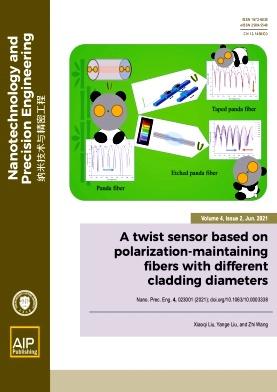利用放电等离子体成像技术比较分析 Ti6Al4V 的超声波辅助和非辅助微型EDM 中的单刻度参数
IF 3.5
3区 工程技术
Q2 MATERIALS SCIENCE, MULTIDISCIPLINARY
Nami Jishu yu Jingmi Gongcheng/Nanotechnology and Precision Engineering
Pub Date : 2024-01-08
DOI:10.1063/10.0023965
引用次数: 0
摘要
超声波辅助微放电加工(μEDM)有可能提高材料去除率(MRR)和表面光洁度等加工响应。要了解这种提高的原因,就需要探索造成单个放电及其形成的凹坑的物理机制。本研究对 Ti6Al4V 传统和超声波辅助 μEDM 在不同参数值下的单次放电形成的凹坑特征进行了研究。对等离子通道进行了高速成像,并实时捕获了单个放电的数据。使用有限元软件建立了二维轴对称模型,以模拟陨石坑的形成。在模拟和实验结果的基础上,进行了对比研究,以检验超声波振动辅助对陨石坑几何形状的影响。对于每一组μEDM 参数,超声波辅助μEDM 的单次放电形成的凹坑直径和深度均高于传统μEDM。陨石坑几何形状的改善和陨石坑边缘隆起的减少归因于模型预测的熔池速度和温度的提高。本文章由计算机程序翻译,如有差异,请以英文原文为准。
Comparative analysis of single-crater parameters in ultrasonic-assisted and unassisted micro-EDM of Ti6Al4V using discharge plasma imaging
Ultrasonic-assisted micro-electro-discharge machining (μEDM) has the potential to enhance processing responses such as material removal rate (MRR) and surface finish. To understand the reasons for this enhancement, the physical mechanisms responsible for the individual discharges and the craters that they form need to be explored. This work examines features of craters formed by single discharges at various parameter values in both conventional and ultrasonic-assisted μEDM of Ti6Al4V. High-speed imaging of the plasma channel is performed, and data on the individual discharges are captured in real-time. A 2D axisymmetric model using finite element software is established to model crater formation. On the basis of simulation and experimental results, a comparative study is then carried out to examine the effects of ultrasonic vibrational assistance on crater geometry. For every set of μEDM parameters, the crater diameter and depth from a single discharge are found to be higher in ultrasonic-assisted μEDM than in conventional μEDM. The improved crater geometry and the reduced bulge formation at the crater edges are attributed to the increased melt pool velocity and temperature predicted by the model.
求助全文
通过发布文献求助,成功后即可免费获取论文全文。
去求助
来源期刊

Nami Jishu yu Jingmi Gongcheng/Nanotechnology and Precision Engineering
Engineering-Industrial and Manufacturing Engineering
CiteScore
6.50
自引率
0.00%
发文量
1379
审稿时长
14 weeks
 求助内容:
求助内容: 应助结果提醒方式:
应助结果提醒方式:


